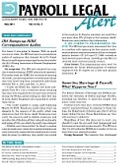Employees can’t be wise consumers of health care services if they don’t understand their group health plans.
Final regulations for implementing the Affordable Care Act health care reform law fill this informational gap by requiring all group health plans (including grandfathered plans, self-insured plans and plans not covered by the Employee Retirement Income Security Act) to provide employees and beneficiaries with a summary of benefits and coverage (SBC) and a uniform glossary that defines basic health benefit terms.
The final regs become effective April 16, 2012, and apply to open enrollment periods that begin on or after Sept. 23, 2012. For newly covered employees and special enrollees, the regs apply to disclosures beginning on the first day of the first plan year that begins on or after Sept. 23, 2012. (77 F.R. 8668, 2-14-12)
Who gets what, when. SBCs provide group plans and employees and beneficiaries with standard information. However, SBCs don’t need to be prepared for excepted benefits—stand-alone dental or vision plans or health flexible spending accounts that cover excepted benefits.
Group health insurers provide SBCs to plans and sponsors when they apply for coverage and when coverage is renewed. Plans must receive SBCs as soon as practicable, but no later than seven business days after applying for coverage. Updated SBCs must be provided when the information in them changes before the first day of coverage.
For automatic renewals of coverage, plans must receive SBCs within 30 days before the start of the new plan year. At the outset, employees must be provided SBCs for every benefit package in which they are eligible to enroll.
To avoid duplication, insurers and plans may agree on the entity that will provide enrollees with SBCs.
With the exception of special enrollees, who must receive SBCs when they receive their summary plan descriptions (SPDs), employees must receive their SBCs:
• Along with written enrollment applications and if applications aren’t distributed, by the first date employees are eligible to enroll
• By the first day of coverage, if new SBCs must be issued due to changes before the first day of coverage
• Along with renewal applications and, if renewal is automatic, SBCs for the option in which employees are enrolled must be provided no later than 30 days before the plan year begins
• 60 days before employees’ coverage is materially modified during the plan year
• Within seven business days after an employee requests one.
SBCs may be provided on paper or electronically through email or an Internet posting if employees routinely access work-related information electronically. The Department of Labor’s (DOL) current rules for electronic delivery apply to enrollees. Employees and beneficiaries who are eligible for coverage but not enrolled may receive electronic SBCs if the electronic format is readily accessible to them.
√ IMPACT ON ERISA-COVERED PLANS: SBCs don’t replace SPDs, but they may be provided along with SPDs, if the SBC information is intact and prominently displayed at the beginning of those materials (e.g., immediately after the SPD’s table of contents). Plans that supply updated SBCs during the year satisfy their obligation to provide employees with summaries of material modifications.
Content requirements. SBCs must be presented in a uniform format and use terminology understandable by average enrollees. They cannot exceed four double-sided pages and must use a print that’s at least a 12-point font. Overall, there are 12 elements that must be included in SBCs.
Break: The DOL has created templates for SBCs, including a sample completed SBC, instructions for completing SBCs and standard language for some sections. Coverage examples and the uniform glossary are also available.
Point your browser to www.dol.gov/ebsa/ for this information.

